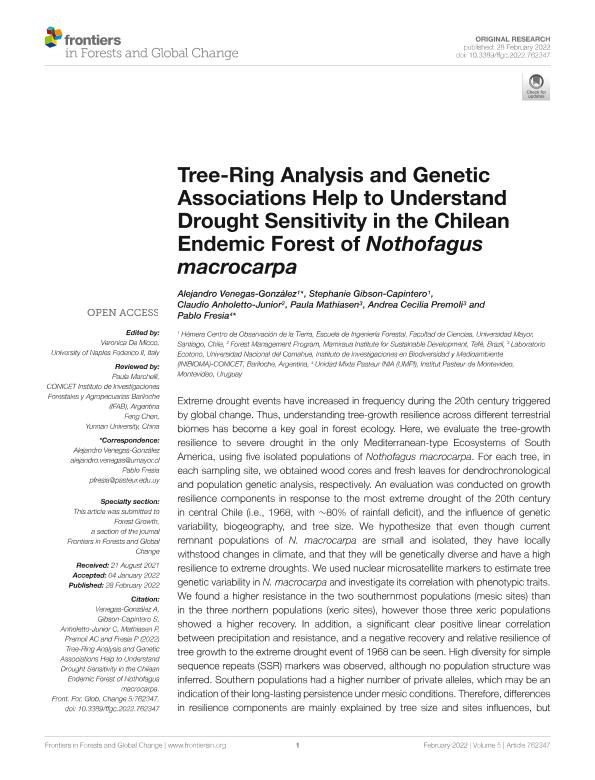Mostrar el registro sencillo del ítem
dc.contributor.author
Venegas González, Alejandro
dc.contributor.author
Gibson Capintero, Stephanie
dc.contributor.author
Anholetto Junior, Claudio
dc.contributor.author
Mathiasen, Paula

dc.contributor.author
Premoli Il'grande, Andrea Cecilia

dc.contributor.author
Fresia, Pablo
dc.date.available
2023-09-22T16:35:44Z
dc.date.issued
2022-02
dc.identifier.citation
Venegas González, Alejandro; Gibson Capintero, Stephanie; Anholetto Junior, Claudio; Mathiasen, Paula; Premoli Il'grande, Andrea Cecilia; et al.; Tree-Ring Analysis and Genetic Associations Help to Understand Drought Sensitivity in the Chilean Endemic Forest of Nothofagus macrocarpa; Frontiers Media; Frontiers in Forests and Global Change; 5; 2-2022; 1-13
dc.identifier.issn
2624-893X
dc.identifier.uri
http://hdl.handle.net/11336/212736
dc.description.abstract
Extreme drought events have increased in frequency during the 20th century triggered by global change. Thus, understanding tree-growth resilience across different terrestrial biomes has become a key goal in forest ecology. Here, we evaluate the tree-growth resilience to severe drought in the only Mediterranean-type Ecosystems of South America, using five isolated populations of Nothofagus macrocarpa. For each tree, in each sampling site, we obtained wood cores and fresh leaves for dendrochronological and population genetic analysis, respectively. An evaluation was conducted on growth resilience components in response to the most extreme drought of the 20th century in central Chile (i.e., 1968, with ∼80% of rainfall deficit), and the influence of genetic variability, biogeography, and tree size. We hypothesize that even though current remnant populations of N. macrocarpa are small and isolated, they have locally withstood changes in climate, and that they will be genetically diverse and have a high resilience to extreme droughts. We used nuclear microsatellite markers to estimate tree genetic variability in N. macrocarpa and investigate its correlation with phenotypic traits. We found a higher resistance in the two southernmost populations (mesic sites) than in the three northern populations (xeric sites), however those three xeric populations showed a higher recovery. In addition, a significant clear positive linear correlation between precipitation and resistance, and a negative recovery and relative resilience of tree growth to the extreme drought event of 1968 can be seen. High diversity for simple sequence repeats (SSR) markers was observed, although no population structure was inferred. Southern populations had a higher number of private alleles, which may be an indication of their long-lasting persistence under mesic conditions. Therefore, differences in resilience components are mainly explained by tree size and sites influences, but not genetic diversity. We concluded that observed differences in tree-growth resilience among sites can be explained by a great deal of phenotypic plasticity, fostered by genetically diverse gene pools. We advocate for a genome-wide analysis (i.e., SNP) so as to identify genomic regions correlated with phenotypic traits in order to improve the understanding of the evolutionary processes that shaped this forest resilience over time.
dc.format
application/pdf
dc.language.iso
eng
dc.publisher
Frontiers Media

dc.rights
info:eu-repo/semantics/openAccess
dc.rights.uri
https://creativecommons.org/licenses/by-nc-sa/2.5/ar/
dc.subject
CHILEAN FORESTS
dc.subject
DENDROECOLOGY
dc.subject
GENETIC DIVERSITY
dc.subject
GEOGRAPHIC ISOLATED FORESTS
dc.subject
GLOBAL CHANGE
dc.subject
MEDITERRANEAN-TYPE ECOSYSTEMS
dc.subject
PHENOTYPIC PLASTICITY TREE-GROWTH RESILIENCE
dc.subject.classification
Conservación de la Biodiversidad

dc.subject.classification
Ciencias Biológicas

dc.subject.classification
CIENCIAS NATURALES Y EXACTAS

dc.title
Tree-Ring Analysis and Genetic Associations Help to Understand Drought Sensitivity in the Chilean Endemic Forest of Nothofagus macrocarpa
dc.type
info:eu-repo/semantics/article
dc.type
info:ar-repo/semantics/artículo
dc.type
info:eu-repo/semantics/publishedVersion
dc.date.updated
2023-06-29T10:33:57Z
dc.journal.volume
5
dc.journal.pagination
1-13
dc.journal.pais
Estados Unidos

dc.description.fil
Fil: Venegas González, Alejandro. Universidad Mayor; Chile
dc.description.fil
Fil: Gibson Capintero, Stephanie. Universidad Mayor; Chile
dc.description.fil
Fil: Anholetto Junior, Claudio. Mamiraua Institute for Sustainable Development; Brasil
dc.description.fil
Fil: Mathiasen, Paula. Consejo Nacional de Investigaciones Científicas y Técnicas. Centro Científico Tecnológico Conicet - Patagonia Norte. Instituto de Investigaciones en Biodiversidad y Medioambiente. Universidad Nacional del Comahue. Centro Regional Universidad Bariloche. Instituto de Investigaciones en Biodiversidad y Medioambiente; Argentina
dc.description.fil
Fil: Premoli Il'grande, Andrea Cecilia. Consejo Nacional de Investigaciones Científicas y Técnicas. Centro Científico Tecnológico Conicet - Patagonia Norte. Instituto de Investigaciones en Biodiversidad y Medioambiente. Universidad Nacional del Comahue. Centro Regional Universidad Bariloche. Instituto de Investigaciones en Biodiversidad y Medioambiente; Argentina
dc.description.fil
Fil: Fresia, Pablo. Instituto de Investigaciones Biológicas "Clemente Estable"; Uruguay
dc.journal.title
Frontiers in Forests and Global Change
dc.relation.alternativeid
info:eu-repo/semantics/altIdentifier/url/https://www.frontiersin.org/articles/10.3389/ffgc.2022.762347/full
dc.relation.alternativeid
info:eu-repo/semantics/altIdentifier/doi/http://dx.doi.org/10.3389/ffgc.2022.762347
Archivos asociados
